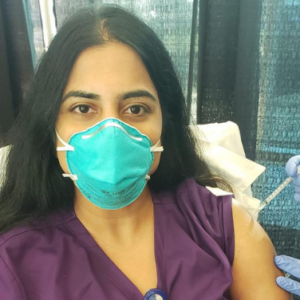News
COVID-19 Vaccines, They’re Our Best Shot
February 5, 2021
Corona Virus Disease 2019 (COVID-19) was declared a pandemic by the World Health Organization on March 11, 2020. Since then, COVID-19 has caused a deadly rampage against populations worldwide with devastating consequences on several fronts. Even with ongoing, robust public health measures such as social distancing and masking in public, as well as enormously heroic efforts by the hospital systems and health care workers to fight this disease, it continues to surge with cases and deaths increasing at an alarming rate. The recently approved COVID-19 mRNA vaccines are among the many essential tools that can help us end this pandemic.
Messenger RNA (mRNA) vaccine technology is not new and has been studied for decades by researchers. The mRNA vaccines have strands of genetic material called mRNA packaged in a special coating that helps it enter the immune cells near the site of vaccination.
The mRNA carries instructions for the cell it enters to make a harmless piece of, what is called the “spike protein,” which is unique to the COVID-19 virus. This piece of the viral spike protein is then displayed on the cell’s surface and is recognized by the immune system. This then triggers antibody production to fight off what the immune system thinks is a COVID-19 infection. The immune system is now trained and ready to protect against future infection from the virus. Since it does not contain the actual virus, it cannot cause COVID-19 illness. It is important to note that the mRNA strand never enters the cell’s nucleus and does not affect genetic material.
COVID-19 vaccines were tested in large clinical trials with thousands of participants to ensure they meet safety standards. After two doses, the vaccines were found to be greater than 95% effective in preventing COVID-19 illness. The vaccines had a very favorable safety profile, with pain at the injection site reported as the most common side effect. Sometimes after vaccination, the process of building immunity can cause symptoms, such as fever. These symptoms are normal and are a sign that the body is building immunity.
To get the best protection against COVID-19, two shots are needed and given three weeks apart. The first shot primes the immune system, helping it recognize the virus, and the second shot strengthens the immune response.
Because the supply of COVID-19 vaccines in the United States is expected to be limited at first, the initial supply of the vaccine is being allocated to health care personnel and long-term care facility residents. As soon as large quantities of the vaccine are available, the goal is for everyone to be vaccinated. Until the pandemic is completely contained, social distancing and masking in public should still continue even after receiving the vaccine.
We are all together in this war against this virus. When you get the call, roll up the sleeves and get that vaccine. It is our best shot!

Geetha Sivasubramanian, MD
About the Author: Geetha Sivasubramanian, MD is board certified in infectious disease by The American Board of Internal Medicine. She is a member of the American Society for Microbiologists, American College of Physicians, and the Infections Disease Society of America. Dr. Sivasubramanian is UCSF School of Medicine faculty teaching the next generation of physicians through UCSF Fresno.
